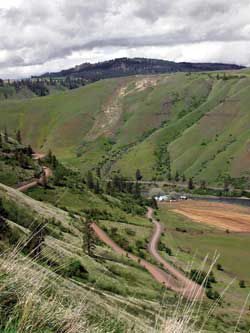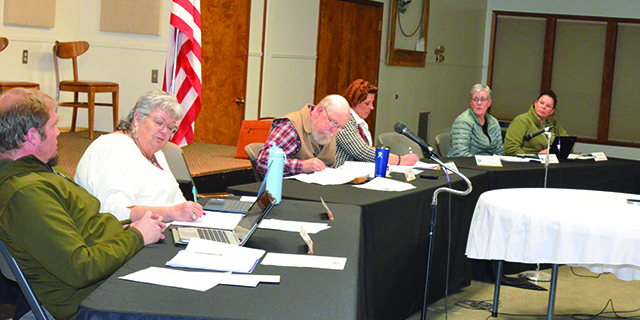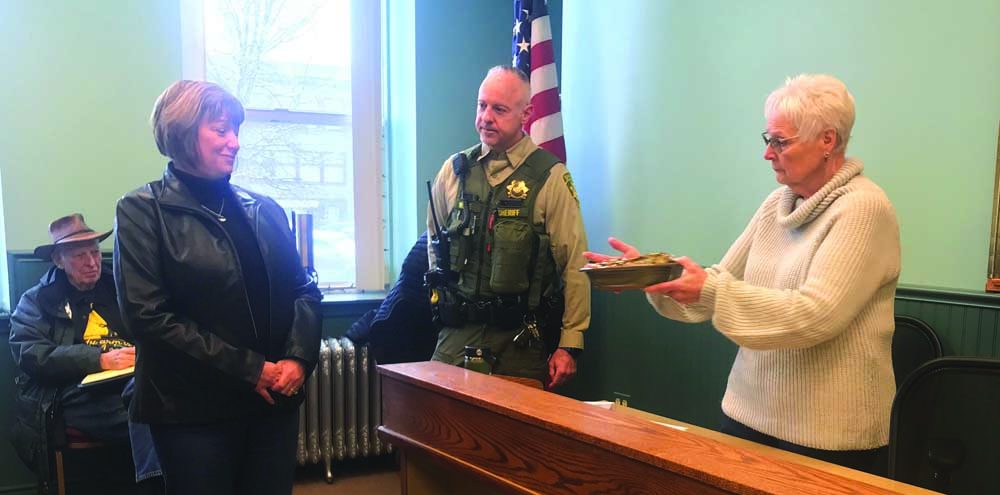Imnaha, Flora, Troy & Minam
Published 5:00 pm Wednesday, May 28, 2008

- Redmond Grade descending into Troy.
The Wallowa Valley corridor – the stretch of land that runs along the Wallowa River, ending at the head of Wallowa Lake – is by far the most visited and populated section of Wallowa County. But there are some off-Highway 82 communities that are well worth discovering.
IMNAHA
The famous Bear and Rattlesnake Feed is now only a fond memory in the rugged little canyon town of Imnaha. But a rattlesnake kill chart on a wall of the 104-year-old Imnaha Store and Tavern continues to record tally marks for each rattler conquered by locals each summer.
Imnaha is an unincorporated community 30 miles east of Joseph at the confluence of the Imnaha River and Little Sheep Creek. About a dozen people live in the town proper, but counting the surrounding farm families the Imnaha Post Office – established in 1885 – delivers mail to 80 households or 175 people in all.
Imnaha is also home to a two-room elementary school and the Imnaha Christian Fellowship Church – the newest structure in town, built by the community in 1991.
Imnaha is a popular destination for fishermen and hunters and – at the relatively low elevation of 1,978 feet above sea level – it is locally known as Wallowa County’s garden spot.
It’s also the take-off point for a scenic 23.5 mile drive south up to Hat Point Lookout, where visitors can look down at Snake River over a mile below. There is a primitive campground near the lookout.
Dug Bar, a long, rough 27-mile drive from Imnaha, provides the only vehicle access to the Snake River and Hells Canyon from Wallowa County, and is a popular exit point for Hells Canyon floaters. For history buffs, Dug Bar is where Chief Joseph crossed the swollen river with his people and livestock when forced to leave the county in 1877.
At the turn of the 19th century, Imnaha was a thriving community with a store, saloon, hotel, blacksmith shop, and – according to a 1900 census – 182 residents. The historic Imnaha Store and Tavern, owned and operated by Dave Tanzey since 1980, is the community’s gathering spot, serving up food, beer, information and grocery staples to locals and visitors alike. Tanzey started the famous Bear and Rattlesnake Feed as a fundraiser for the Multiple Sclerosis Society in 1988. It became so popular that many folks would plan their vacations around it, helping to put Imnaha on the map in terms of state media coverage. Tanzey, his wife, Salley, and the many volunteers who put on the feed finally called it quits, however, and the last snake and bear event was held in 2004.
The Imnaha store, once owned by Lloyd Doss (a former member of the Sons of the Pioneers, the cowboy singing group still famous for backing up Roy Rogers), has been on the market for several years now. But for now, the Tanzeys continue to carry on at the town’s only store and restaurant while also managing a three-room motel and four-space RV park. Call 541-577-3111 for reservations.
Five miles downriver on the road to Dug Bar, visitors can also find lodging from owners Nick and Sandy Vidan at the Imnaha River Inn bed and breakfast – a custom-built, 7,000 square foot log lodge which combines ruggedness and luxury. Call 541-577-6002 or visit www.imnahariverinn.com for details.
Rattlesnake may no longer be on the menu here, but Imnaha, is still a WOW-worthy place to visit.
FLORA
Anyone who’s ever wanted to know how to make soap like they did in the pioneer days, plow a field or eat a tasty meal baked in a Dutch oven is invited to Flora School Days at the historic Flora Schoolhouse on the first Saturday in June.
In its heyday, the town of Flora was the flourishing center of trade for the rugged farming and ranching community of the north end of Wallowa County. At one time, it was home to several hundred residents, living in and around town. It had two general stores, two hotels, three blacksmith shops, a post office, a two-story school, a newspaper, a dental office, three shingle mills, a telephone office, a warehouse, a church and many houses. But the two world wars, the consolidation of agricultural land and improved transportation ended up decimating the town’s population. The last store shut its doors in the 1960s, the post office was discontinued at the end of 1967, and the last student left the school in 1975.
For many years, an occasional chili feed, flea market or old-time dance at the North End Grange Hall were about the only signs of community life in Flora, which had become a virtual ghost town. Since then, however, there has been a modest resurgence, centered around the old Flora School, built in 1915, which is in the process of being restored. The building was derelict – and had come close to being torn down to make room for a junkyard – when Dan and Vanessa Thew Thompson of Umatilla County purchased it in 1992.
The Thompsons finally achieved their goal of moving to Flora a couple of years ago, and they have since opened the North End Crossing Barn and bed and breakfast in the old newspaper office.
This year’s fourth annual School Days celebration on Saturday, June 7, will offer wagon rides, pioneer skills demonstrations, homemade pie served by the North End Grange, and old-time music. For more information, call 541-828-8010 or e-mail floraschool@tds.net.
TROY
The tiny canyon community of Troy sits at the confluence of the Grande Ronde River at the extreme north end of Wallowa County, close to the Washington state border.
Its most popular attractions include steelhead and fly fishing, hunting, and rafting the Grande Ronde. Hikers, too, enjoy trails up the Wenaha River where the scenery is breathtaking and wild animals, including Rocky Mountain sheep, are often spotted. Some of the biggest elk in the state are found in the Wenaha hunting unit. The months of May and June are when wildflowers along the mountain sides and canyon are the most spectacular.
According to locals, Troy’s population is roughly 18 people, 50 turkeys and a dozen deer. Approximately 16 residents are scattered along Eden Bench, along with part-time turkeys, elk, deer and, most recently, moose, while Bartlett Bench boasts about the same population mix, in addition to an unknown number of cows.
The only real business in town is the Shilo Oasis Resort, owned by hotel-chain magnate Mark Hemstreet. It offers a full breakfast, lunch and dinner menu during the summer months, as well as cabins, an RV park and gasoline.
Troy has the smallest school district in the state, with local children – six this year – educated in a one-room schoolhouse that also serves as community gathering center.
Bill and Emma Wilson homesteaded the Troy site in 1898, and the first post office opened in 1902. The first bridge across the Grande Ronde was completed in 1910, and a flourmill began operation two years later. The town grew from a population of about 25 to 100 after a sawmill opened in 1946, but Troy’s life as a mill town ended in 1954.
Things livened up in the late 1970s and early 1980s, when an event called Troy Days drew 15 rock-and-roll bands and many people to town.
Other family-friendly events now held in Troy include an Easter potluck and an old-fashioned Fourth of July Celebration, highlighted by a parade and fireworks. This year, on June 28, Troy will help host the 57-mile Mt. Misery Relay Run, which starts in Asotin, Wash.
Six roads leads to Troy, but only two are open in the winter, for all practical purposes. They are the Flora route, about 56 miles from Enterprise, and the Oasis route along the Grande Ronde River from the Lewiston highway at the foot of Buford grade, just beyond the Washington state line. Other routes, best to avoid in the winter, are north to Pomeroy, Wash., and Tollgate, Wildcat and Powwatka in Oregon.
MINAM
Minam is an unincorporated community in northwestern Wallowa County, at the confluence of the Minam and Wallowa rivers north of the Wallowa Mountains on Oregon Route 82 – approximately 20 miles northeast of La Grande. Minam was named after the Minam River, which in turn was named in honor of the Native American name for the locality E-mi-ne-mah, which described a valley or canyon where a plant used for food that resembled a small sunflower was abundant. Minam’s post office was established in 1890, closed in 1891, reestablished in 1910 … and closed again in 2006.
The primary launch site for the Wallowa and Grande Ronde corridors, as well as the Bureau of Land Management public contact station, are located on state lands at Minam.





